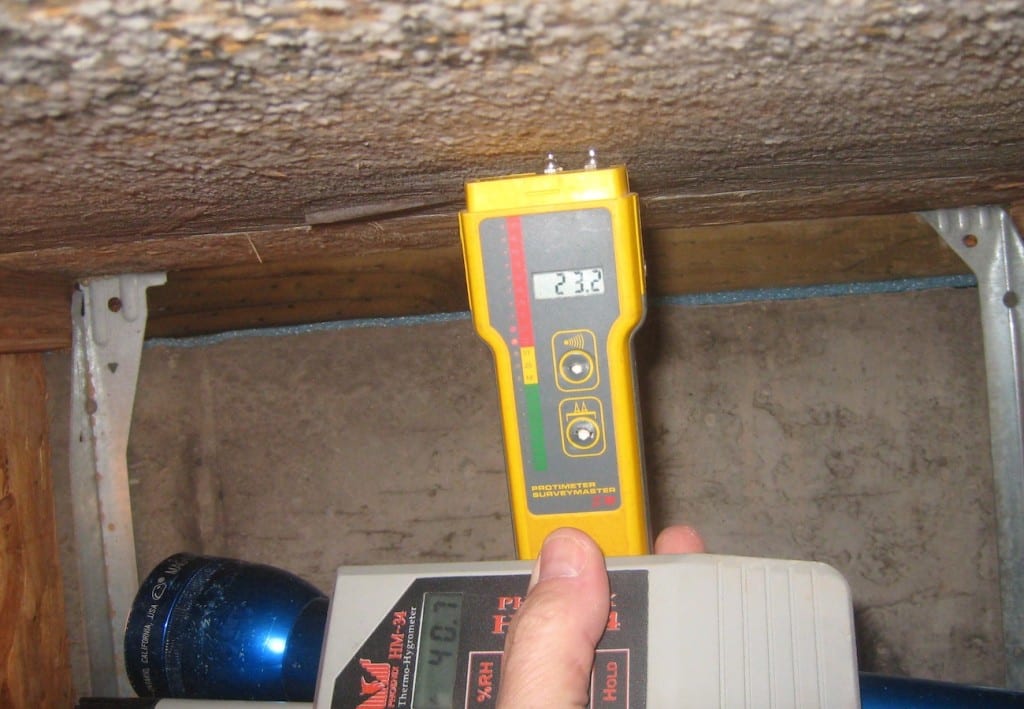This is an example of what we are capable of producing, when asked to perform a comprehensive mold investigation and report on conditions found. Our collective expertise includes inspection and mold remediation.
Gary Gilman, CMRS and President of SteamMaster and Colorado CrawlSpace, inspected the entire crawlspace at XXX XXX XXX Road on 2/22/2016 with XXX XXXXX.
There was a very significant musty odor emanating from the crawlspace soil which made it difficult to breathe without wearing a respirator. The damp crawlspace soil was covered with a thick coating of a substance that appeared to be some sort of macro-fungi and mineral deposits.
I pulled back the fiberglass batt insulation from the north and west rim joists and found the rim joists in these areas to be saturated and completely rotten. An investigation around the perimeter found moisture condensing behind the batt insulation in most places with approximately two thirds to three quarters of the exterior rims exhibiting some level of structural decay.
The adjoining plywood subfloor sheathing and the ends of the 2×12’ floor joists also showed mold damage, rot and structural decay in the worst areas. Digital photographs were taken to record these finds and are available with this report via drop box.
A humidistat with three wires coming from it was observed near the center of the crawlspace. Condensation was also observed dripping from the gas pipes and the sheet metal ducting near the humidistat fans. Water droplets were also observed near the top of the concrete foundation wall in areas.
The center posts were installed several feet below the crawlspace grade and showed signs of standing water 12”-18” high on the posts. A structural engineer had already investigated these posts and recommended installing sauna tubes or concrete footings to above the height of the soil and starting the posts at this height rather than remaining sunken and exposed to standing ground water
I agree with the engineer’s recommendations regarding these repairs and additionally recommend filling all the depressions with some sort of slurry, concrete or structural fill to raise the grade to the same height as the surrounding soil.
I also recommend the overall soil to make it relatively level and sloping to the perimeter foundation walls. I also recommend an interior perimeter drain tile bedded deeply in gravel to raise the grade around the perimeter trench to be at the height of the perforated white drainage pipes which currently exist.
I would also recommend the installation of a Basement Systems TripleSafe sump pump system with ice guard and lawn scape outlets to discharge about 15’ away from the foundation wall towards the creek. A possible location for the discharge pipe would be near the exterior hose bib on the creek side of the home.
Most of the subfloor and floor joists throughout the center areas of the crawlspace were in excellent shape; however there were a few areas with visible mold present which should be remediated along with the perimeter.
I recommend the removal of the rotten perimeter rim joists by a carpenter experienced with these types of repairs. The attachment areas can be efficiently and effectively cleaned to remove mold and surface rot using the Cold Jet Cryo-Blast cleaning system. After these attachment areas are properly cleaned, I recommend coating these areas with an EPA registered fungicidal coating such as FiberLock AfterShock. This is a white pigmented product.
After this has been completed, the structural integrity of the impacted and remediated areas can be assessed by the structural engineer or general contractor and they can determine what methods would be best utilized while installing new rim joists and re-attaching the floor joists.
Once the mold and rot around the perimeter have been properly remediated and repaired, the grade has been raised and the drainage and sump pump installed, I recommend installing a dimpled drainage matting and a 20 mil CleanSpace crawlspace liner over the entire soil and having it mechanically fastened to the perimeter foundation wall above the height of the existing white perforated drain pipes. A perforated drain tile can be installed under this liner to make the system ‘radon ready’ if desired.
A dehumidifier can also be installed to help reduce humidity and prevent condensation. I would also recommend using a closed cell polyurethane spray foam insulation around the new rim joists along the perimeter. These rim joists should be made of treated lumber.
SteamMaster and Colorado Crawl Space have worked successfully on these types of foundation repairs in the past with XXX XXXXX of XXX XXX Builders in Glenwood Springs.
A CrawlSpace science booklet and a packet of information about SteamMaster and Colorado Crawl Space services have been delivered. More information is available at www.steammaster.com or calling 800.527.1253

